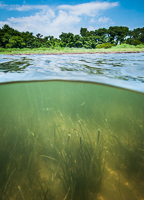Abstract
Seagrass meadows provide numerous ecosystem services including biodiversity, coastal protection, and carbon sequestration. In Europe, seagrasses can be found in shallow sheltered waters along coastlines, in estuaries & lagoons, and around islands, but their distribution has declined. Factors such as poor water quality, coastal modification, mechanical damage, overfishing, land-sea interactions, climate change and disease have reduced the coverage of Europes seagrasses necessitating their recovery.
Research, monitoring and conservation efforts on seagrass ecosystems in Europe are mostly uncoordinated and biased towards certain species and regions, resulting in inadequate delivery of critical information for their management. Here, we aim to identify the 100 priority questions, that if addressed would strongly advance seagrass monitoring, research and conservation in Europe. Using a Delphi method, researchers, practitioners, and policymakers with seagrass experience from across Europe and with diverse seagrass expertise participated in the process that involved the formulation of research questions, a voting process and an online workshop to identify the final list of the 100 questions.
The final list of questions covers areas across nine themes: Biodiversity & Ecology, Ecosystem services, Blue carbon, Fishery support, Drivers, Threats, Resilience & Response, Monitoring & Assessment, Conservation & Restoration, and Governance, Policy & Management, Communication. Answering these questions will fill current knowledge gaps and place European seagrass onto a positive trajectory of recovery.
DOI: 10.1002/ppp3.10486









